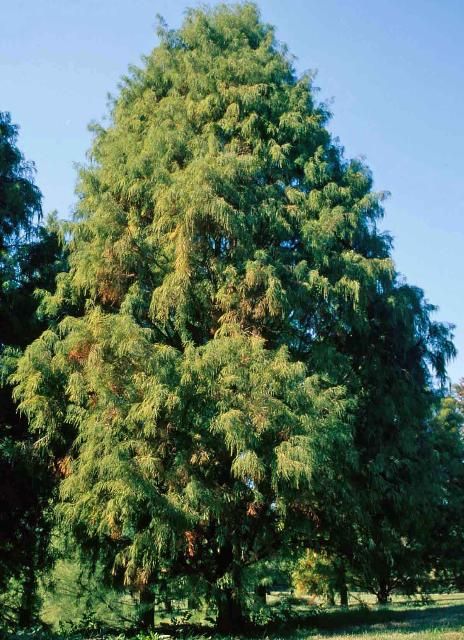Introduction
The unusually wide-spreading, pyramidal form on 'Monarch of Illinois' baldcypress eventually develops into a broad-topped, spreading, open specimen when mature. Landscape specimens will probably grow more than 100 feet tall. Spread on this cultivar is typically about two-thirds the height, so allow plenty of room. Trees grow at a moderately fast rate, reaching 40 to 50 feet in about 15 to 25 years. Although it is native to wetlands along running streams, growth is often faster on moist, well-drained soil. The pale green, needle-like leaves turn a brilliant coppery red in fall before dropping, but the bare branches and reddish gray, peeling bark provide much landscape interest during the winter. The trunk grows unusually thick toward the base, even on young trees. The small seeds are used by some birds and squirrels.

Credit: Ed Gilman, UF/IFAS
General Information
Scientific name: Taxodium distichum
Pronunciation: tack-SO-dee-um DISS-tick-um
Common name(s): 'Monarch of Illinois' baldcypress
Family: Taxodiaceae
USDA hardiness zones: 5A through 11 (Fig. 2)
Origin: native to North America
Invasive potential: little invasive potential
Uses: urban tolerant; street without sidewalk; screen; sidewalk cutout (tree pit); reclamation; parking lot island < 100 sq ft; parking lot island 100-200 sq ft; parking lot island > 200 sq ft; tree lawn 3-4 feet wide; tree lawn 4-6 feet wide; tree lawn > 6 ft wide; highway median; shade; specimen; hedge
Availability: not native to North America

Description
Height: 60 to 90 feet
Spread: 60 to 70 feet
Crown uniformity: symmetrical
Crown shape: pyramidal
Crown density: dense
Growth rate: fast
Texture: fine
Foliage
Leaf arrangement: alternate (Fig. 3)
Leaf type: simple
Leaf margin: entire
Leaf shape: linear, lanceolate
Leaf venation: none, or difficult to see
Leaf type and persistence: deciduous
Leaf blade length: less than 2 inches
Leaf color: green
Fall color: yellow, copper
Fall characteristic: showy

Flower
Flower color: brown
Flower characteristics: not showy
Fruit
Fruit shape: round, oval, cone
Fruit length: .5 to 1 inch, 1 to 3 inches
Fruit covering: dry or hard
Fruit color: brown, green
Fruit characteristics: attracts squirrels/mammals; not showy; fruit/leaves not a litter problem
Trunk and Branches
Trunk/bark/branches: branches droop; showy; typically one trunk; thorns
Pruning requirement: little required
Breakage: resistant
Current year twig color: green
Current year twig thickness: thin
Wood specific gravity: 0.46
Culture
Light requirement: full sun
Soil tolerances: sand; loam; clay; acidic; slightly alkaline; well-drained; extended flooding
Drought tolerance: high
Aerosol salt tolerance: moderate
Other
Roots: not a problem
Winter interest: yes
Outstanding tree: yes
Ozone sensitivity: unknown
Verticillium wilt susceptibility: resistant
Pest resistance: resistant to pests/diseases
Use and Management
Although often seen at water's edge where it will develop "knees", or root projections, that will extend above the water, baldcypress can also be grown in dry locations and makes an attractive lawn, street, or shade tree. Cypress knees do not generally form on these drier sites. Cities from Charlotte, NC, Dallas, TX to Tampa, FL currently use the species as a street tree and it should be used more extensively throughout its range in urban landscapes. It provides a good vertical accent to the landscape and should be used more often in urban areas. Baldcypress can be clipped into a formal hedge, creating a wonderful soft screen.
Surprisingly, the roots do not appear to lift sidewalks and curbs as readily as some other species. Its delicate, feathery foliage affords light, dappled shade, and the heartwood of baldcypress is quite resistant to rot. However, most lumber available at lumber yards today is sapwood and is not resistant to rot.
Baldcypress is ideal for wet locations, such as its native habitat of stream banks and mucky soils, but the trees will also grow remarkably well on almost any soil, including heavy, compacted, or poorly-drained muck, except alkaline soils with a pH above 7.5. Locate where the sun will strike the tree on all sides for best symmetrical development. Baldcypress is relatively maintenance-free, requiring pruning only to remove dead wood and unwanted drooping lower branches which persist on the tree. It maintains a desirably straight trunk and a moderately dense canopy, and does not form double or multiple leaders as do many other large trees.
The cultivar 'Shawnee Brave' has a narrow, pyramidal form, 15 to 20 feet wide. 'Pendens' has drooping branchlets and large cones. Taxodium distichum var. nutans (Taxodium ascendens) is native to wet, boggy areas with standing water, whereas Taxodium distichum is most common along streams.
Propagation is by rooting cuttings.
Pests
Mites can be particularly troublesome in dry summers without irrigation, causing early leaf browning and defoliation in mid to late summer. Bagworms can cause some cosmetic damage.
Diseases
Twig blight is caused by a weak pathogen and is usually present on dead or dying tissue. When the tree is stressed the fungus can kill branch tips. Dead tips can be pruned off. Do not let dead or diseased branches remain on the tree. Keep trees healthy with regular fertilization.